
Is Aspen a Hockey Town at Heart?
Image above: Al Beyer skates on Maroon Lake in November 2018. Photo by Pete McBride
On a warm evening in March 2018, as skiers slide toward après-ski, another Aspen tradition plays out on a different frozen world downtown. Beneath the long shade of Shadow Mountain, a group of locals gathers for a weekly symphony of skates inside a beige building once known as the Palace.
It is Tuesday night, and the finals of the men’s hockey league are unfolding below the flickering glow of a scoreboard in the Aspen Ice Garden, as former pros, Division I college players, and old goats—or, more accurately, has-beens and never-weres—battle away for what may be the hardest-earned, least-known trophy in nonprofessional hockey: the Pell Cup. Named after longtime Aspenite Peter Pell (a notoriously sharp-tongued player who never won the cup himself), this dented piece of pewter is a horrible, miniature replica of the Stanley Cup, the National Hockey League’s holy grail. If you look past the beer and whiskey stains, you will see nearly a half century of Aspen’s history etched in the names of its hockey clubs, sponsored by bars, camera stores, laundromats, and other long-gone businesses.
I’ve laced up the blades for this local league on and off for nearly three decades and skated in this season-ending game only a handful of times. Behind Aspen’s international skiing luster lies a deep, competitive hockey culture that makes for a tough beer league. A drive to win the bragging rights to the battered Pell Cup turns architects, bartenders, contractors, lawyers, teachers, ski bums, and friends into fierce, fist-throwing rivals. And this Tuesday night, to no one’s surprise, the level of play is fast and feisty.
After one rowdy battle in the corner for the puck against longtime friend and hockey coach Lindsey Holmbeck, I return to the bench, more winded than usual. My middle-age lungs and heart are screaming at me. I’m quite sure Lindsey’s are, too. The score is 1 to 1, boosting the intensity to a palpable level. A small gathering of boozy fans, many of them players from the league’s other three teams, adds to the Ice Garden’s fervor, as they lob more insults than cheers. The old Palace is pulsing.
For a brief second, while catching my breath, I take stock of this community of rink rats around us, both on and off the ice. Our team has two “kids” that Lindsey and I coached years ago—Reid Hansen and Jesse Amory. Both are now schooling us in fitness. My brother Johno once coached three other players: Ezra Louthis, Pete Scott, and Pitkin County Sheriff’s Deputy Tony Todaro. Many of the other guys coach now as well. When we get together for beers post skate, we all joke how our skills are collectively rusting, but our enthusiasm for the game is getting shinier. It is the classic inverse relationship with age: as athleticism fades, it’s replaced with the last and only tool left—passion for the game.
“Check it out, the godfather made it tonight,” says someone on the bench. I look across the rink and eye my 80-year-old father, John, who watches through the plexiglass, bundled up and grinning. Next to him stand my mother, Laurie, my sister, Kate, and my nephew, Jasper, all players in their own right. “All the generations are out tonight,” I say, still panting. “We better bury the biscuit [score goals], lads.”
My old man was a hockey stud in his day, breaking records thanks to his speed and his lethal slap shot. But I know him more as a hard-nosed coach who expected a lot from his ski-town skaters—and made no exceptions for his offspring. Dad played on the 1961 US Hockey Team and held the season record of 54 points (goals and assists) at Princeton University for nearly six decades. The week before this Pell Cup final, a senior finally broke it. My dad casually ceded the record—“58 years was long enough,” he said—but I could tell it stung, at least slightly.
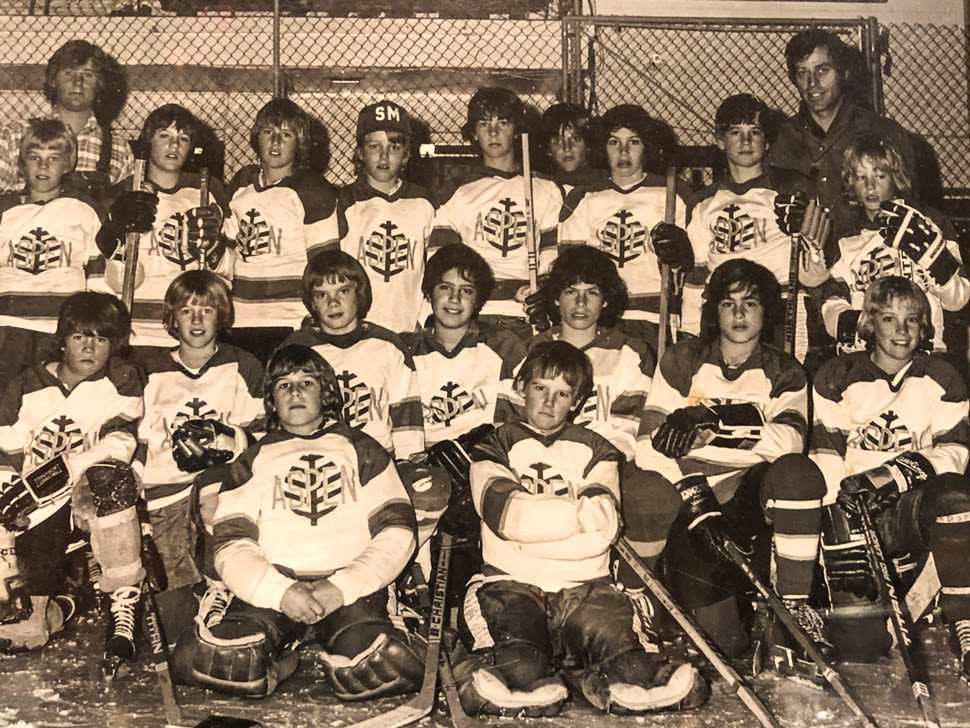
Peewees team with Coach John McBride in 1979
Image: Courtesy: Pete McBride
My own college hockey career came nowhere near any records, unless someone was tallying bench time. I was proud to walk on to the Division I team at Dartmouth, but, like many Aspen hockey kids who scrap their way into bigger arenas, I didn’t go further. I spent most of my game time at the college level riding the pine on a losing squad. Perhaps watching our team take back the Pell Cup tonight would soften my father’s unspoken sorrow at losing his record. Plus, it would be fun to add our team’s name somewhere below that of my old man’s.
For many in this old hockey house, my father is known not for his player stats but rather for his steady influence as a coach, advocate, and fan. Like many parents, he simply loves the game and sees it as an integral tool for teaching life lessons and building community, especially in a ski town. “You can’t only ski,” he would tell us as kids. “Team sports are good.”
That wasn’t always the case here. In earlier days, hockey wasn’t part of the valley’s DNA like it is now. In 1957, as skiing was just finding its legs locally, D.R.C. Brown stepped in as president and general manager of the fledgling Aspen Ski Corporation. He and his wife, Ruth, paid $200 for what is now the “pink house,” which was next to a horse corral on the southwest corner of town. When the corral went up for sale, Ruth Brown decided that an outdoor ice rink—modeled after Sun Valley’s, where waiters delivered hot cocoa on skates—was the answer to protecting her mountain view. No towering new condos—just leaping figure skaters and gliding hot toddies. And so, in 1963 or 1964—depending on which source you consult—Aspen’s first public rink was launched—the only artificial sheet of ice in Western Colorado.
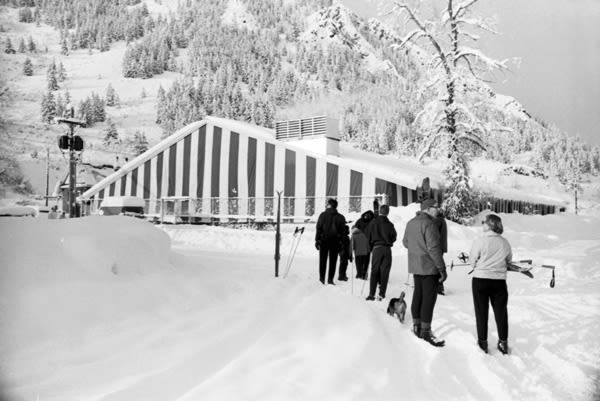
The Brown Ice Palace in 1965
But Ruth quickly realized that a shed roof with canvas sides was needed to protect the extensive piping needed for the ice. “She ended up with a far larger, and far uglier, building than condos,” laughs her daughter, Ruthie, who still lives in Aspen and was bestowed the childhood chore of opening and closing the canvas sides. “But she did create something that represents the best of Aspen’s spirit—a place for community.”
Initially, the Brown Ice Palace, as it was called, catered to figure skating and was managed by Olympic silver medal skater Lefty Brinkman, who was also the ski school director at Aspen Highlands. “But then your dad came along,” recalls Ruthie.
Fresh off the national team, my father wanted to get more folks shooting pucks. “Originally, I convinced Lefty to partner with some of us,” he says, “but we were given terrible ice times for hockey—5 a.m. or 10 p.m. Figure skaters owned the show.” In a move to gain more hockey time, my dad—along with friends David Baxter, Charlie Cole, and Bill Tharp—proposed to buy the rink from Ruth in the early 1970s. She agreed, then after doing so, asked to be the fifth partner.
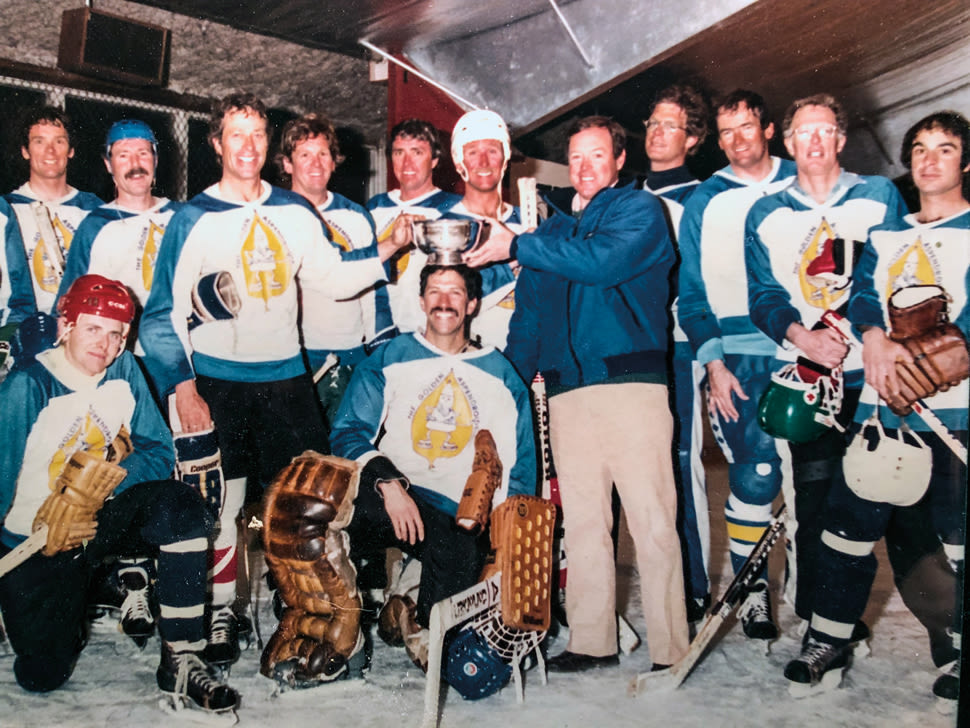
The 1980 Pell Cup champions
Image: Courtesy: Pete McBride
Thus was born the official Aspen Junior Hockey program, known as the Aspen Leafs. “At first we were kind of a joke, with some 15 kids, but we had ice time,” says my dad nostalgically. The Palace was soon renamed the Aspen Ice Garden and boasted a colorful logo of flowers bursting from an old leather skate.
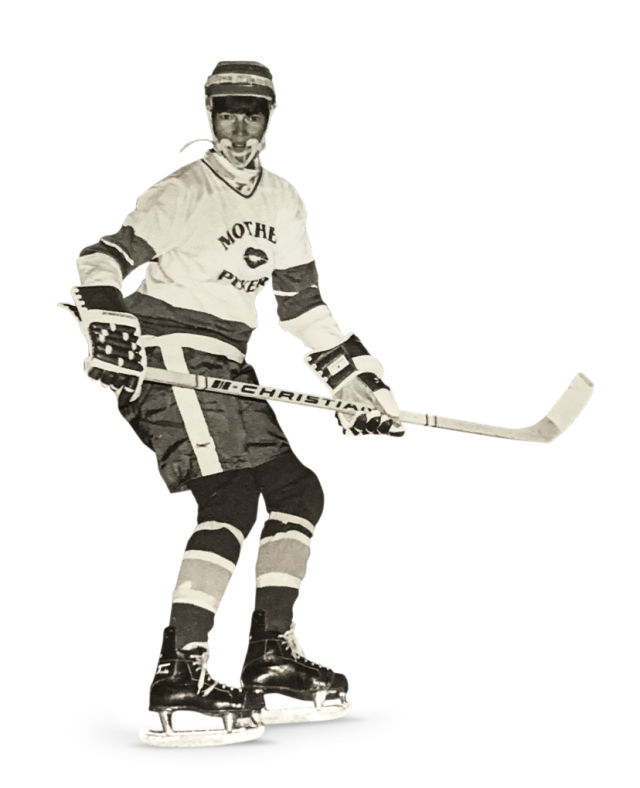
Laurie "Moutie" McBride
Image: Courtesy: Pete McBride
At the time, I was 1. My brother and sister were 7 and 5, respectively. The steel-girded Ice Garden—its roof insulated with asbestos that frequently snowed onto the ice—became our home away from home. When my father wasn’t working, he was coaching or playing with his pals on the Aspen travel team. My mother quickly joined the mix and played with the young Ruthie Brown, Cathy Crum, and other moms on the Mother Puckers women’s team, which still battles in the corners today, my sister frequently among them. “Barely any of the Puckers knew how to skate back then,” says Ruthie now. “But, wow, how we all laughed.”
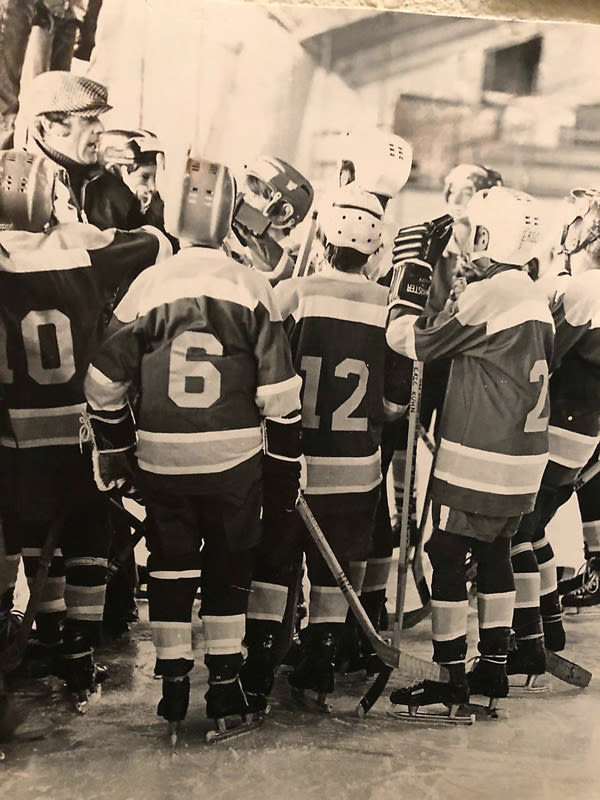
Coach John McBride with a Bantams team in the late 1970s
Image: Courtesy: Pete McBride
The rink was the town’s babysitter, where every kid in Junior Hockey hung out. The Marlows, the Cottrells, the Giles, the Kellys, the Kashinskis, the Godfreys, the Clarks, the Fitzgeralds, the Bennings, the Zeits, the Crums, the Baxters, the Tribecks, the Sadrons … we all lived there.
If we weren’t skating, we were outside playing street hockey, boys and girls alike. Since girls’ hockey didn’t exist, players like Beth Madsen and Ali Crum (Cathy’s daughter) also skated with the boys, often leading the charge. (Beth would later ski race in the 1988 Olympics and Ali would play Division I hockey for Harvard.)
Despite Aspen’s depth of athletic prowess, the program struggled initially. Opposing teams from Denver sported full rosters, matching jerseys, and amply developed skills. Aspen was lucky just to fill a squad, let alone find enough equipment. My brother and his teammates used Life magazines for shin guards, as the closest hockey store was four hours away. Eight years later, my Squirt team goalies, Josh Goldman and Brian Dunlop, had to share pads, making for awkward goalkeeper exchanges if one was having a bad game.
Nonetheless, volunteer coaches like Hugh Marlow, James Bond, Danny Harris, and many others held the program together, pushing our ski-conditioned legs to do more crossovers, more wind sprints, and take more shots on the ice. For a few years, Eric Nesterenko, a longtime NHL player and Stanley Cup winner, coached us just because he liked being near skiing so much. I remember our Squirt team oohing in delight when he proudly removed his retainer of fake teeth—a pro’s career written in porcelain.
Since few other ski towns at the time had hockey programs, parents like Chuck Torinus were integral to keeping seasons afloat by packing us into his Suburban for the long haul to Denver on the two-lane interstate, snow or shine, for every away game.
On one trip home, we urged Chuck to stop at the Georgetown Reservoir so we could play puck on its natural ice. As younger kids, many of us had skated on Twin Lakes when Independence Pass stayed open late in the fall. It was our version of hockey heaven—clear, black ice stretching for miles. Sensing an opportunity for more heavenly ice in Georgetown, we cheered as Chuck drove the Suburban straight onto the frozen lake, joining other (smaller) vehicles. But before we could even lace up, the ice cracked and the Suburban sank—slowly enough that we all escaped unharmed. (The vehicle and most of the hockey gear were salvaged the next spring.)
As hockey became more established in Aspen, so did our skills. The 18-0 losses turned into wins, followed eventually by state and even regional titles. In 1980, the City of Aspen bought the Ice Garden, yet within a decade the program outgrew the rink. With ice time again in high demand, the only time the high school team could practice was at 11 p.m. In 2003, after years of community collaboration and fundraising, the Lewis Ice Arena, with an NHL-size rink, opened at the new Aspen Recreation Center to accommodate the increasing number of skaters.
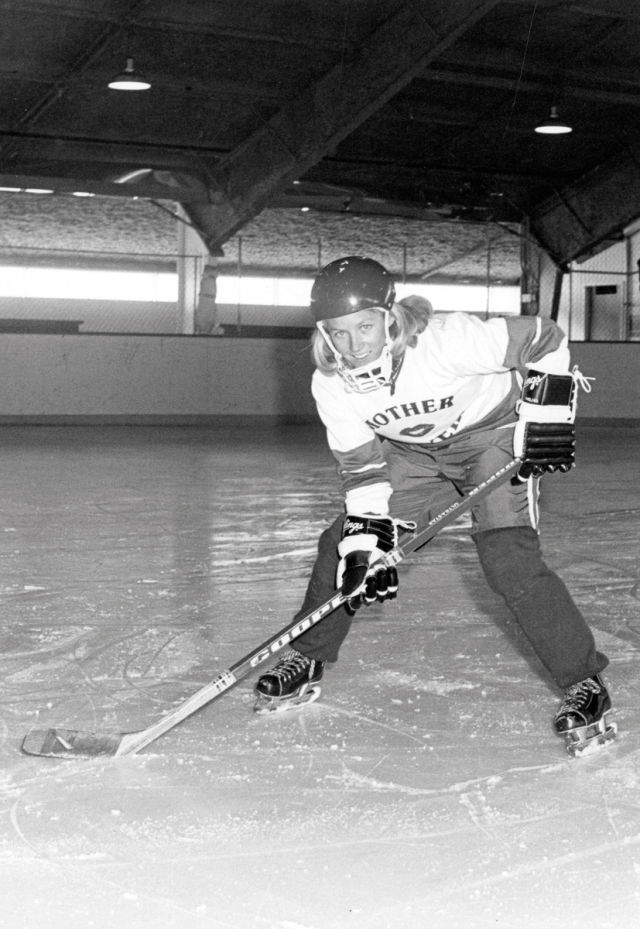
Mary Sloop of the Mother Puckers in 1980
Today, this once “joke of a program” has made long strides. With nearly 300 kids ages 4 to 18, some 40 coaches (including recent NHL pro David Clarkson), and two city-owned rinks, Aspen has become a regional hockey force. The program, directed since 2013 by Shaun Hathaway, continues year-round with three leagues and occasional exhibition games with NHL alums. In 2016, a partnership was forged with the Finnish Ice Hockey Association, and in what’s now turned into a 10-year agreement, a coach annually comes to Aspen for a six-month stint to work with young players here.
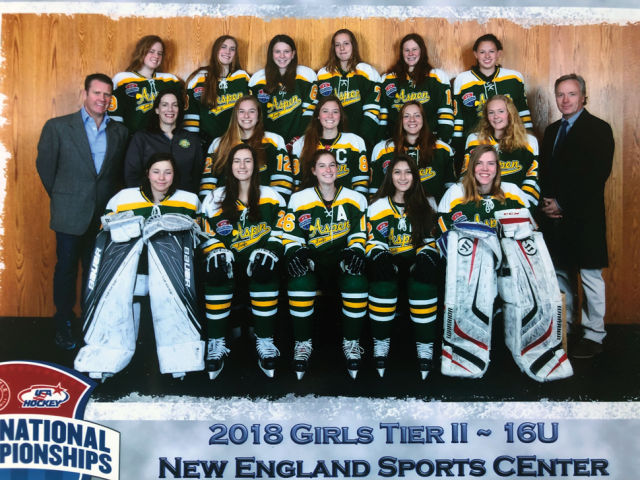
The 2018 girls team Tier II, 16U and coaches
Image: Courtesy: Pete McBride
Meanwhile, the Mother Puckers have gone from a “tea party on ice” (in the words of some original players) to having two squads and winning regional titles. And perhaps most impressive is the full-fledged Aspen Junior Hockey girls’ program, founded by Wily Mannering and Cathy Crum, with support from former Pucker skater and tennis legend Martina Navratilova. When it started in 1992, it was the first girls’ program in Colorado. It’s grown into a powerhouse, with some 100 girls in Aspen playing across six teams—more than many youth programs have in total. Each of the past two years, a local girls’ team has skated in USA Hockey’s National Championships. Overall, so many state- and regional-title banners hang from the Lewis Ice Arena’s ceiling (junior players have racked up more than 75 ) that many prior to 2000 have been mothballed.
Back at the Pell Cup finals, I ready up for another shift late in the game, pouring sweat and looking for my long-lost third-period legs. I glance at my line mate Al Beyer, the younger Ruthie Brown’s husband. “Let’s go get one,” I say.
He nods and leaps over the boards. Al is our team sponsor, our oldest skater, and our most enthusiastic player by far. Ruthie says her mother loved the fact that the greatest Ice Garden rink rat of them all was her son-in-law. I follow Al on to the ice and quickly get in a foot race with Coley Cassidy, a former teammate from childhood.
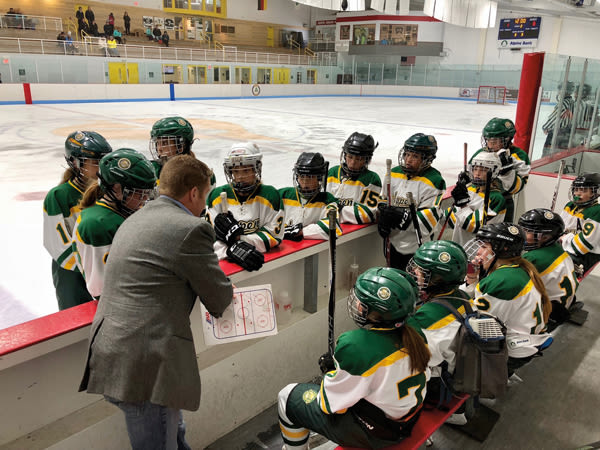
Coach Coley Cassidy and his girls’ team
Image: Megan Bourke
Coley chased his hockey dreams through college, then all the way to a professional career in Norway. I dig my strides in deeper, knowing that winning the puck from him won’t be easy. Like many Aspen Junior Hockey alumni, Coley returned to the rink he grew up in to be a volunteer coach. Over the last decade, he and fellow coach Keith Howie have led scores of girls’ teams to state and regional titles. Both Keith and Coley’s daughters inherited the hockey gene and play on teams from Aspen to prep schools. When I later ask Coley to sum up his feelings about the Ice Garden and our history there, he smiles and says, “It’s the best—nothing has changed. It even smells the same.”
Ultimately, our mixed-age team takes the win by two goals. After hoisting the cup like the pros do and showing off to the remaining drunk fans, we gather for the traditional team photo—middle-aged dudes cheering like exuberant teenagers. Shortly after the game, both teams drink together from the Pell Cup, swapping stories and laughs and adding another dented chapter to the old trophy.
Eight months later, much of our team and a slew of other skaters gather one crisp mid-November weekend on Maroon Lake. It’s rare that the lake is cold enough to skate on this early in the season. Black ice spreads below the snow-dusted peaks and generations of skaters quickly fall into games of shinny. Al Beyer and I join a group of high school players. A light snow muffles the sounds of cutting blades and the subtle thud of a stick and puck. The sounds of winter.
I marvel at the skaters around us and wonder who may go on to win another junior title or play in a cheering college arena or beyond. I know that if they are lucky, some will return to Aspen and compete for a title in the best beer league, played in the greatest mountain ice garden, in the world.
Aspen’s Ice Age
1963/64
Brown Ice Palace erected
1964
Bob Johnson Ice Hockey School starts in Aspen
1972
Ruth Brown sells Ice Palace, which is renamed Aspen Ice Garden; John McBride and friends found Aspen Junior Hockey (a.k.a. the Aspen Leafs)
1974
Mother Puckers women’s team starts

The Mother Puckers in 1974.
1980
City of Aspen buys Ice Garden;
chain-link fence around ice is replaced with plexiglass and
asbestos ceiling is covered
1984
Aspen BB Peewees (the writer’s team)
is first local team to win a state tournament
1992
Aspen Junior Hockey girls’ program launches under Wily Mannering and Cathy Crum
1995
Daily Awards for sportsmanship instituted, commemorating Kathy Daily and sons Tanner and Shea, who were killed in an accident in Glenwood Canyon while returning from a hockey game in Vail
1998
Aspen girls’ Tier 1 team makes US national championships
2001
Stirling Cup fundraising weekend started by Jody Cooper
in honor of her late husband, Stirling Cooper
2003
Lewis Ice Arena built at the Aspen Recreation Center
2006
Mother Puckers win regional title
2007
Aspen High team wins its first state championship
2017
Daniel Doremus (one of five local hockey-playing brothers) signs with the
San Jose Sharks American Hockey League affiliate
2018
First Aspen girls’ team to win a game at USA Hockey National Championships
2019
The 39th Pell Cup finals take place in March
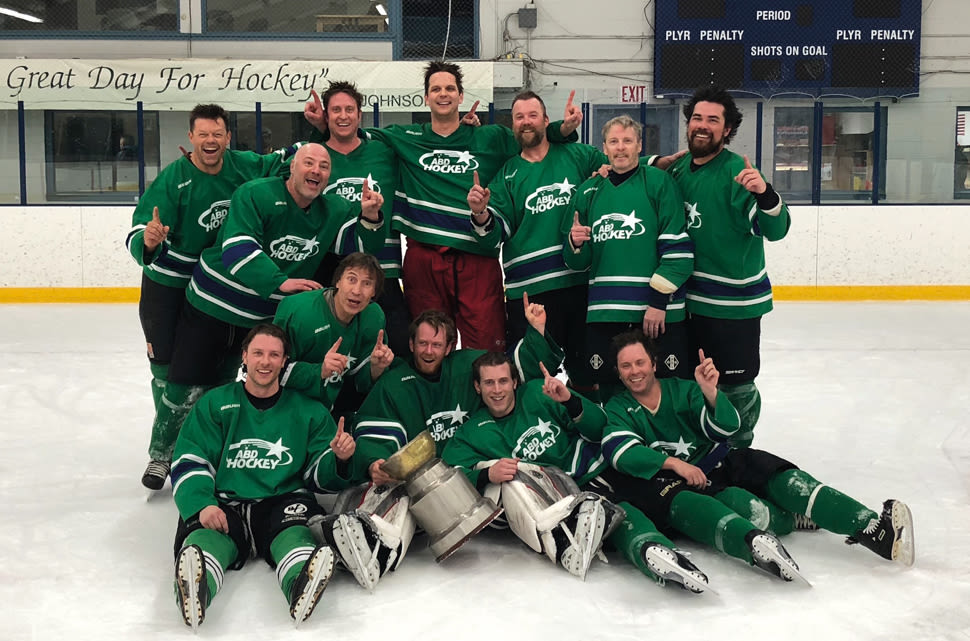
The author’s team that captured the 2018 Pell Cup
Image: Courtesy: Pete McBride














































